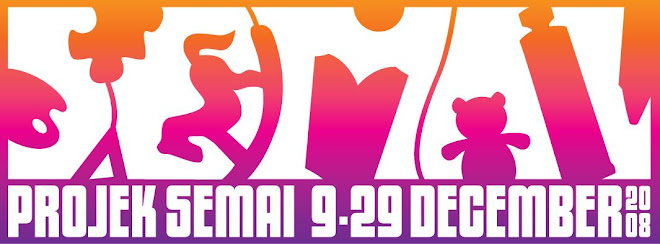Date: 28 December 2008
Time: 10-11am
Participants: Chin Yi Ton, Hee Li Jie, Lai Shu Wei, Lai Wei Shen, Lim Jun Hong, Saw Khe Xin, Wong Kah Lok, Wong Kai Wei
---
'Draw what you have seen during the journey from your house to here.' This was the first sentence, and the participants started to trace back their memories.
 George Seurat's A Sunday Afternoon on the Island of La Grande Jatte (1884), a classic example of pointillism.
George Seurat's A Sunday Afternoon on the Island of La Grande Jatte (1884), a classic example of pointillism.
 So what's this?
So what's this?  Pixel rendition of Evening in Venice by Monet.
Pixel rendition of Evening in Venice by Monet.
...I then asked them to imagine what's the original image without the filters. The response from this exercise sounded better than the former.
Pause while the leaves were traveling in group - Question asked: Where do you think the leaves are heading to? Draw it out. Meanwhile consider the previously observed environments, weather and season.
2) Superflat Monogram (commercial)
from Louis Vuitton, directed by Takashi Murakami
URL: http://www.youtube.com/watch?v=4C84FLwm3DA
3) Bad Eggs (animation)
4) Grrr (commercial)
- How many chickens did you see?
Also in the dvd I have Tim Burton's first short and Björk's Wanderlust, but time didn't allow me to show them. I thought the videos are interesting still, show if any of you would like to watch them, just click!
I continued the videos after they drew what's in their mind. Though I skipped this for 'Bad Eggs' which made them a little upset and kept begging me to tell the actual 'thing' inside the egg, this was funny. I told them what's in the egg was what they drew and for those who weren't satisfied with such ludicrous answer, I asked them to dream about it at night.
Still they went back with a lot of noise calling me the bad guy. :D
Well, if any of the participants read this, click the url and watch it here then. Good luck.
*Projek Semai has no affiliation with any of the above directors/image makers/singers who created/produced the short films/videos. The film works were picked simply because we believed it has the value of creating suspense and triggers the children's imagination, where it would be of good use in this workshop.













 Many thanks to the very young enthusiastic artists (in alphabetical order): 升 aka Chan Yun Sheng, 俊杰 aka Chong Jun Kiat, 轩 aka Lai Ming Xuan, 宏 aka Lim Jun Hong and Wolise aka Wong Kai Wei for such an amazing job, even till the last day! Drop some comments!
Many thanks to the very young enthusiastic artists (in alphabetical order): 升 aka Chan Yun Sheng, 俊杰 aka Chong Jun Kiat, 轩 aka Lai Ming Xuan, 宏 aka Lim Jun Hong and Wolise aka Wong Kai Wei for such an amazing job, even till the last day! Drop some comments!











































